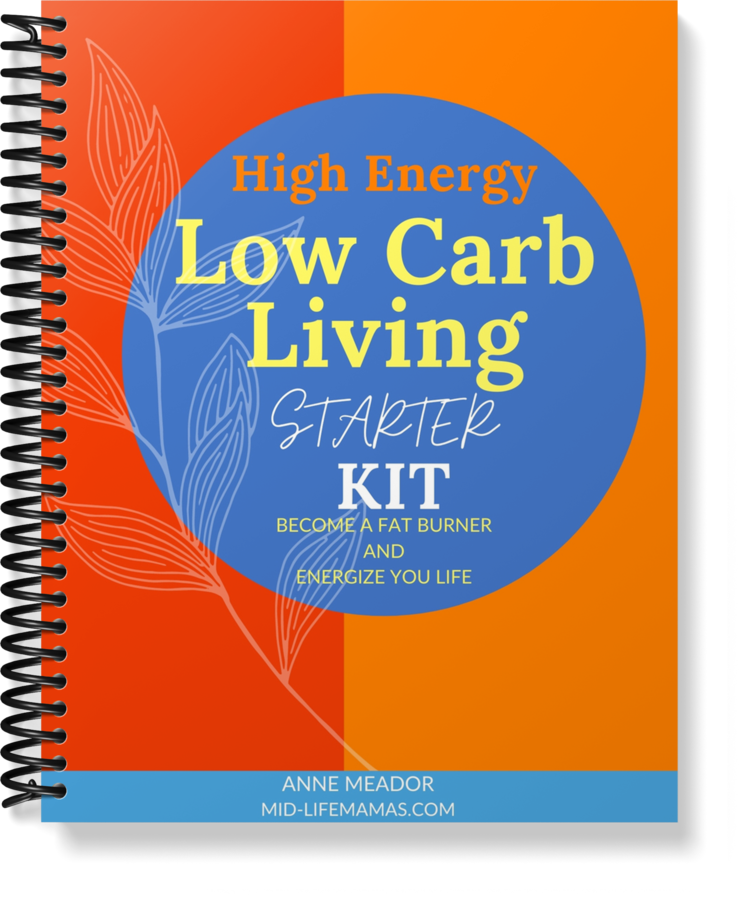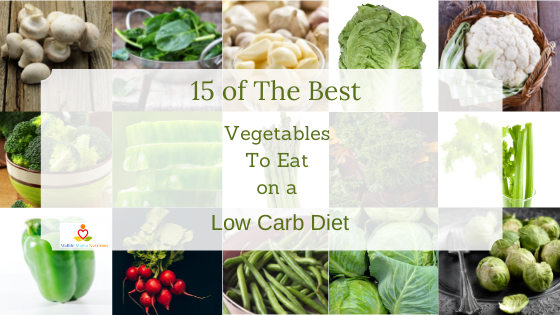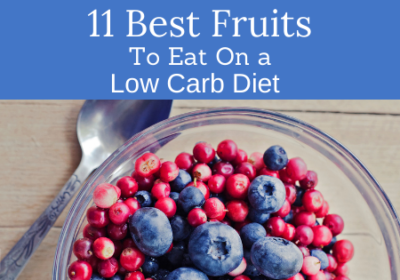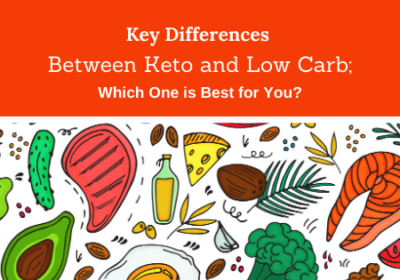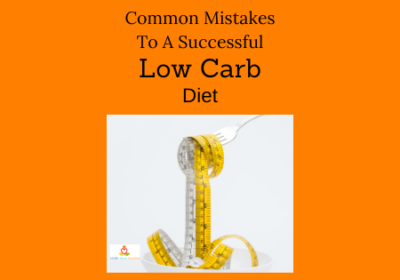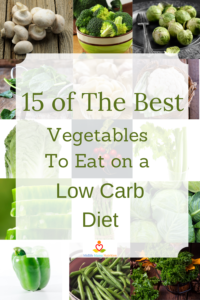
If you guessed avocados, guess again. You know why? Because Avocados are technically a fruit. But it doesn’t matter what you call it, as long as you call it a staple in your Low Carb diet. But it’s also OK if you don’t like them because there are plenty of other fruits and vegetables to help you lose weight on a Low Carb Diet. Here are 15 of the best vegetables to eat on a Low Carb Diet
In our high-energy low-carb lifestyle, we recommend that your daily intake of carbohydrates is 25% or less of your daily food intake or less than 100 grams of carbohydrates a day.
Most vegetables aren’t high in sugars like many fruits are. But, if you’re counting carbs, it’s important to know the better choices to make. Here are the best 15 low-carb vegetables you may want to include in your Low Carb diet. When I say best, I’m talking about low amounts of net Carbohydrates, which are total carbohydrates minus grams of fiber. Grams of sugar were also taken into account when putting this list of the 15 bests vegetables to eat on a low-carb diet.
Get our FREE High Energy-Low Carb Lifestyle Starter Kit
1. Romaine Lettuce
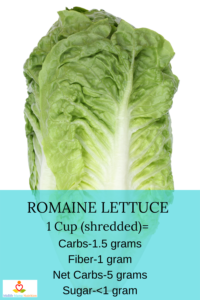
My mom always told me that I had to eat my “green leafies.” Now that I’m on a low-carb diet, dark green lettuces such as Romaine are the foundation of my lunches every day.
Romaine lettuce provides the crunchiness that’s not always easy to find when eating a low carb or keto diet. It’s high in minerals such as calcium, phosphorus, magnesium, and protein. It also has high levels of vitamin C and vitamin A. Both of which are antioxidants that fight against disease and support your immune system. [1]
It’s also a good source of folate, potassium, and vitamin K.[2]
Romaine lettuce is the base of a Caesar Salad, which is a great thing to eat on a low-carb diet because of the high-fat dressing. Minus the croutons, of course.
2. Spinach
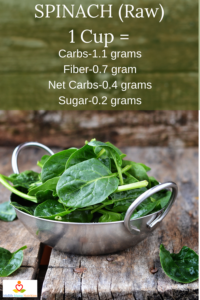
Spinach is not only delicious, but it’s also extremely rich in vitamin K. It has 1,111% of the Daily Recommended Value of vitamin K when it’s cooked and 181% when it’s raw. Your body needs Vitamin K for blood clotting, bone metabolism, regulating blood calcium levels, heart health, and helping wounds heal.
No wonder spinach is one of the best vegetables to eat on a low carb diet.
Who knew Popeye was a low “carber?”
The nutritional value of raw spinach is significantly different than cooked spinach. For example, raw spinach has 1.1 grams of carbs compared to 6.7 grams when it’s cooked. [3][4]
How about a low-carb Spinach Salad with Warm Bacon Dressing?
3. Garlic

Garlic is not only good to keep vampires away, but it’s good at keeping away the common cold [5] and decreasing blood pressure [6]. It’s also said to lower cholesterol, reduce the risk of heart disease, reduce bone loss, and improve memory.
Health benefits aside, it’s delicious and a necessary ingredient in so many recipes. If you haven’t tried roasted garlic, you should try some; it’s delicious and has a nutty flavor.
Get our FREE High Energy-Low Carb Lifestyle Starter Kit
4. Celery
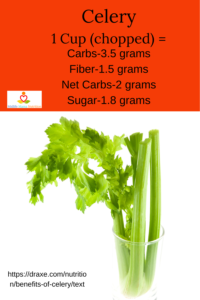
Celery is another great vegetable if you’re missing “crunchiness” in your low-carb diet. It also has a handy groove in the middle where you can add your favorite low-carb nut butter, cream cheese, or spinach dip.
Potential health benefits of celery include lowering high cholesterol and blood sugar. This is due to a unique compound called 3-n-butylphthalide. Celery can also lower inflammation because of the antioxidants it contains. It also can decrease blood pressure, helps prevent ulcers, protect the liver, support digestion, fight infections, and may even help prevent urinary tract infections. [7]
5. Mushrooms
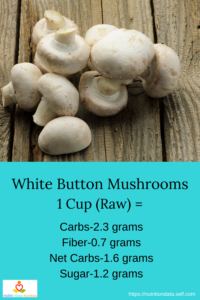
There are many different types of mushrooms, and some have incredible health benefits. However, the most common cooking mushroom, the white button mushroom, is extremely low in carbs and has many health benefits.
White button mushrooms contain many antioxidant compounds that have the potential to fight cancer. Not to mention they’re delicious too!
Try them stuffed, sautéed, or raw.
Get our FREE High Energy-Low Carb Lifestyle Starter Kit
6. Cabbage
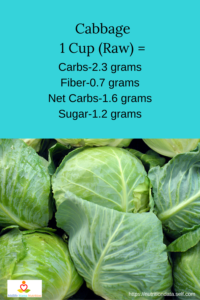
Cabbage may not seem like the most exciting vegetable, but it’s delicious with corned beef on St. Patty’s day and yummy on a picnic in coleslaw.
It is, however, exciting when it comes to health benefits. It’s packed with vitamins and minerals, including 85% of the daily requirement for vitamin K and 54% daily value for vitamin C. [8] They also contain many different antioxidants that have been shown to reduce inflammation in the body [9]. The health benefits go on and on.
6. Cauliflower
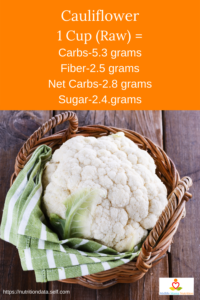
Cauliflower is one of the most popular low-carb vegetables. You see it in stores and restaurants used as a substitute for many things, including mash potatoes, rice, and my personal favorite pizza crust.
It’s high in vitamin C, folate, antioxidants, and choline. Choline is an essential nutrient that many people are deficient in, which plays a major role in your cellular health.
7. Zucchini
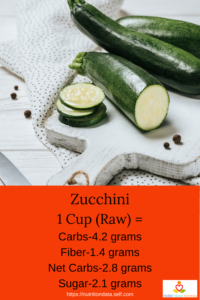
Zucchini is another popular low-carb food. You’ve probably seen zucchini “zoodle” recipes online or in your local grocery store. Zoodles are “zucchini noodles.” which fills the spaghetti void you get when you live a low-carb lifestyle.
Not only is zucchini loaded with vitamins, minerals, and antioxidants. It contains zeaxanthin and other compounds that help prevent oxidative stress, which reduces the likelihood of developing cancer [10]
8. Broccoli
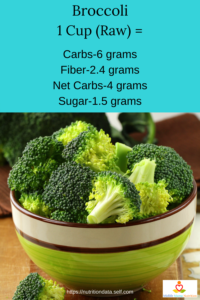
When it comes to vitamin C, you can’t beat broccoli, well maybe you can, but one cup of raw broccoli contains 135% of your daily required amount. It also has 116% of the Daily Value of Vitamin K.
It’s another vegetable with powerful antioxidants that reduces inflammation and cell damage.
Try roasting broccoli in the oven at 350 degrees with drizzled avocado oil and garlic cloves, YUMMY!
Get our FREE High Energy-Low Carb Lifestyle Starter Kit
9. Brussel Sprouts
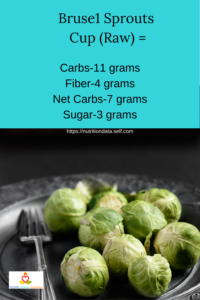
I didn’t start eating brussel sprouts until I started eating a low-carb diet. I have no idea why because they are so delicious, especially roasted. They don’t have the greatest smell, so that may be the reason. But I repeat, they are DELICIOUS.
Brussel sprouts are high in vitamins and minerals, including vitamin C, vitamin K, Folate, Calcium, Iron, and Potassium [11]
10. Asparagus
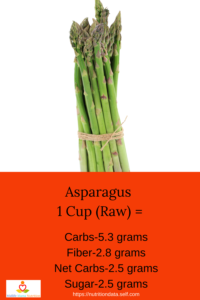
Have you ever asked yourself, why does my pee smell funny after I eat asparagus? If you haven’t noticed the odd (foul) odor, your body may not have the metabolic ability to break down the culprit, which is asparagusic acid. Or you may not have the ability to smell it. Either way, asparagus is a great vegetable to eat on a low-carb diet that has many health benefits.
Asparagus is a great source of nutrients including vitamin C, Vitamin A, Vitamin K, Folate, Potassium, phosphorous, and vitamin E. [12]
As most of these low-carb vegetable asparagus is delicious when roasted in the oven. Preheat the oven to 425 F, coat the baking sheet with a healthy oil such as avocado, drizzle some more avocado oil on top of the asparagus. Bake for 10-15 minutes, and then add some mozzarella or parmesan cheese on top for 5 minutes. Bon Apetit!
11.Kale
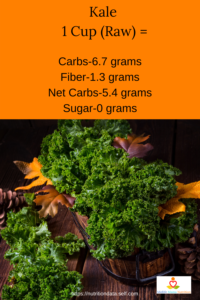
Kale is probably the most popular low-carb friendly vegetables out there. If you haven’t tried kale chips, you may want to put that on your to-do list. The biggest problem with kale chips is that they shrink up after you cook them, and they’re so delicious, so they don’t last very long (did I eat all of those?)
It is considered a superfood because of it’s high nutritional value. It’s high in antioxidants, calcium vitamins C and K, iron and many more.
According to Medical News Today, some evidence exists that kale may offer protection against diabetes, may support heart health provides many other health benefits. [13]
12. Green Beans
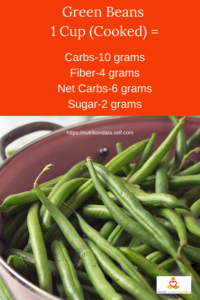
Good old green beans make the list. I don’t know about you, but green beans have always been a staple in my home, both growing up and now as a parent. Throw in some bacon and enjoy!
Green Beans are however still beans so the old adage applies, “Beans, beans the magical fruit, the more you eat the more you toot.” This is because they can cause digestive discomfort due to the protein lectin. If you have digestive problems when eating green beans try to cook them more, that should help.
Like most vegetables, green beans contain essential vitamins, which means they are essential to your health, but your body can’t make them in sufficient amounts. Hence, you have to get them from food (preferable) or supplements (backup plan).
Green beans are a good source of vitamins A, C, K, as well as minerals calcium, magnesium, phosphorous, and potassium. They are also high in fiber, folate, and protein.
Get our FREE High Energy-Low Carb Lifestyle Starter Kit
13. Sweet Green Bell Peppers
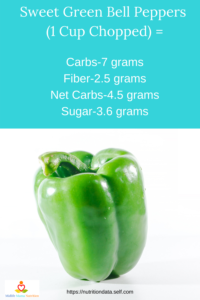
Not only are sweet peppers a great low carb food by itself, but it’s also delicious with your favorite low carb stuffing like tuna or salmon salad. They also have that crunch that is sometimes missing from low carbohydrate diets. Try adding them to your next vegetable platter with your favorite dip.
Fun Fact: Green peppers have double the amount of vitamin C by weight than oranges [14].
They are also high in Vitamin B6, Vitamin K, Potassium, Vitamin E, Folates and Vitamin A [15].
14. Cucumbers
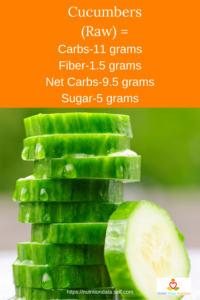
Cucumbers are another crunchy, low carbohydrate vegetable great to use with dips or as a “boat.” Nope not a boat for the kids to play with in the bathtub, but as part of your meal or as a snack. Cut the cucumber lengthwise, use a spoon and scoop out the seeds (now you have a boat)—scoop in your favorite low-carb cream cheese spread or salad such as tuna, chicken, or egg. The possibilities are endless. Use your imagination, and share below in the comments.
Although cucumbers are actually a fruit, most people think of them as a vegetable. Cucumbers are mainly water (96%) but are high in Vitamin K, Potassium, Manganese, and Magnesium. They contain antioxidants, promote hydration, may also lower blood sugar, and can promote regularity (regular bowel movements). [16]
15. Radishes
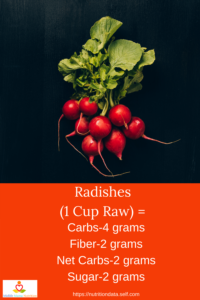
Radishes are mostly used in salads to add some crunch, peppery taste, and color.
They are rich in antioxidants and minerals such as calcium and potassium. Radishes help lower high blood pressure and reduce the risk of heart disease. They are also a good source of natural nitrates that are said to improve blood flow.
If you want to reap the health benefits of radishes besides eating them in a salad, you may want to try baking them or roasting them with garlic and avocado oil.
Get our FREE High Energy-Low Carb Lifestyle Starter Kit
Don’t Skimp on Vegetables While on a Low-Carb Diet
Vegetables must be an integral part of everyone’s diet, and that includes a low-carb diet. They, of course, are packed with vitamins, minerals, antioxidants, fiber, and protein and should be eaten with each meal.
If you’re adhering to a strict low-carb or keto diet by counting carbs, be careful not to overlook their importance. Vegetables are great on a low-carb diet because raw and some cooked vegetables are crunchy, which is missing from many other low-carb foods. Try incorporating some or all of these best 15 vegetables to eat on a low-carb diet
If you’re not actually counting carbs but are on a low carb diet, it’s helpful to use the “rule of thumb” that root vegetables that grow underground, such as potatoes, are carbohydrates and should be avoided where possible.
What are your favorite low-carbohydrate vegetables that you think should be included as one of the best vegetables to eat on a low carb diet. What are your favorite ways to cook them?

